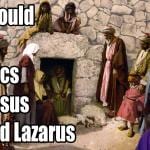With public worship and gathering of large groups suspended, many Catholic parishes and other charities or apostolates are feeling the pinch. Donations are down, so looking ahead they are unlikely to make payroll and thus have to lay off employees.
However, it looks like 501(c)3 corporations (the legal status of most parishes & Catholic apostolates) can get a government loan to cover 10 weeks of salary which the government will then forgive if used on salary. This seems like a way parishes and small charities can keep everyone on staff even if in a financial pinch. The biggest obstacle is that this only applies to 501(c)3 corporations under 500 employees so if the whole diocese is classed as one 501(c)3 and it’s medium to large, this may not be applicable. My experience says that different dioceses vary a bit in legal structure. However, there are other programs for larger 501(c)3s that could be pursued at a diocesan-wide level.
I hope many Catholic parishes, schools or other apostolates can use this part of the stimulus to keep people on staff and get through this crisis. I had noted a few people online mention that parishes could use this program but I had not seen a summary of this for parishes and similar, so I’m posting this in the hopes that pastors see it.
I want to thank Timothy Gutwald of Miller Johnson Attorneys for the following summary.
Obviously, this is general legal information and not specific legal advice. I am neither an accountant nor a lawyer (Mr. Gutwald is the latter). The summary below is for information purposes only and does not create or constitute a lawyer-client relationship. Mr. Gutwald encourages readers who have specific questions or problems to consult a lawyer.
Paycheck Protection Program:
Executive Summary of Key Considerations & Provisions
- It is now the law. President Trump signed the legislation on March 27. Further guidance on administrative aspects of the Paycheck Protection Program (“PPP”) should be available in the coming days. The Administration is seeking to make funds available by the end of next week. PPP loans would be available through June 30.
- $349 billion in loans will be available to small businesses. Small businesses are generally those with fewer than 500 employees, but the employee limit for some industries may be as high as 1,500. For any business with between 500-1,500 employees, we should confirm its NAICS code and check against the SBA size of business tables to see if the business is eligible for a higher employee threshold.
- Section 501(c)(3) not-for-profit entities are eligible borrowers (if fewer than 500 employees), as are self-employed, independent contractor and “gig economy” workers.
- Subject to limited exceptions (e.g., restaurants, food service providers, hotels, SBA-registered franchises and businesses receiving SBIC funding), entities under common control will only be eligible for one PPP loan. So, for example, subsidiaries will generally be grouped with parent companies, and private equity portfolio companies will typically be grouped together.
- The maximum loan for any borrower is equal to 250% of the borrower’s average monthly “payroll costs” (see definition below) for the one-year period prior to the loan date, subject to a maximum of $10 million.
- For purposes of the CARES Act, “payroll costs” include salaries; wages; vacation, parental, family, medical, and sick leave; allowances for dismissal or separation; payments for group health care benefits, including insurance premiums; and retirement benefits.
- However, “payroll costs” excludes any compensation paid to an employee in excess of an annualized amount of $100,000; amounts paid to persons who reside outside the United States; certain taxes imposed or withheld during the covered period; and certain payroll costs for which tax credits were allowed pursuant to the Families First Coronavirus Response Act.
- No collateral or personal guarantees are required. The business also does not need to show it is unable to obtain credit elsewhere. No fees to apply for or close on PPP loans.
- Loans may generally be used for the following purposes: payroll costs (defined above), group healthcare benefit costs during paid sick/medical/family leave, insurance premiums, employee salaries and commissions, mortgage interest payments, rent, utilities and interest on existing debt.
- Loans are forgivable to the extent used for specified purposes. Loan forgiveness will be equal to the amount of payroll costs (excluding any portion in excess of $100,000 for any individual), group healthcare benefits and insurance premiums, mortgage interest, rent obligations and utility payments, in each case, paid during the eight-week period following the borrower’s receipt of the loan.
- However, this loan forgiveness may be reduced based on the borrower’s employee retention and compensation. The amount of a loan to be forgiven will be reduced pro rata based on:
- Any reduction in the average number of full-time equivalent (FTE) employees employed by the borrower during the eight-week measurement period beginning on receipt of the loan, as compared to one of the following (at the borrower’s election):
- the average number of FTE employees per month employed between February 15, 2019, and June 30, 2019, or
- the average number of FTE employees per month employed between January 1, 2020, and February 29, 2020.
- Compensation reductions per employee of more than 25% versus compensation during the most recent full quarter for which the employee was employed before the eight-week measurement period.
- HOWEVER, the loan forgiveness calculation is made without regard to reductions in FTE employees or individual employee compensation between February 15, 2020 and 30 days after the date of enactment of the CARES Act, so long as such position elimination or compensation reduction is reversed by June 30, 2020.
- Any loan forgiveness is not The portion of any loan forgiven in accordance with the CARES Act is excluded from gross income for federal taxation purposes of each applicable borrower.
- To the extent not forgiven, the loan would be repayable over a maximum of ten years and subject to a maximum interest rate of 4.0%. There are no prepayment penalties.
- All loan payments (principal, interest and fees) are deferred for at least six months, possibly up to one year. It is unclear how the final deferral period will be determined/calculated for any given loan.
- This is a Small Business Administration (SBA) program. The loans will technically be made by SBA-approved banks and credit unions, but will be guaranteed by the SBA.
- Clients should reach out to their existing banking relationship contacts ASAP to confirm whether their institution will be a participating lender in the Paycheck Protection Program and what specific information may be needed by that bank or credit union.
- PPP loans are not subject to the restrictions you may have read about relating to stock buy-backs, dividends, and executive compensation. Those restrictions will apply to loans made to businesses outside of the SBA lending programs (e.g., loans to airlines or other large companies).
- Paycheck Protection loans should be evaluated in the context of any other loan or debt obligations of the business. Before applying for a forgivable SBA loan, the borrower should review existing loan agreements, notes, and bond or trust indentures to determine whether incurring additional debt will cause a default or otherwise violate the terms of those agreements. Working with an existing lender that is also processing PPP loans will likely be the most efficient way to mitigate these potential issues/pitfalls.
Note: as always, money is tight on my end too so I really appreciate if you can donate via Patreon to support me.
















